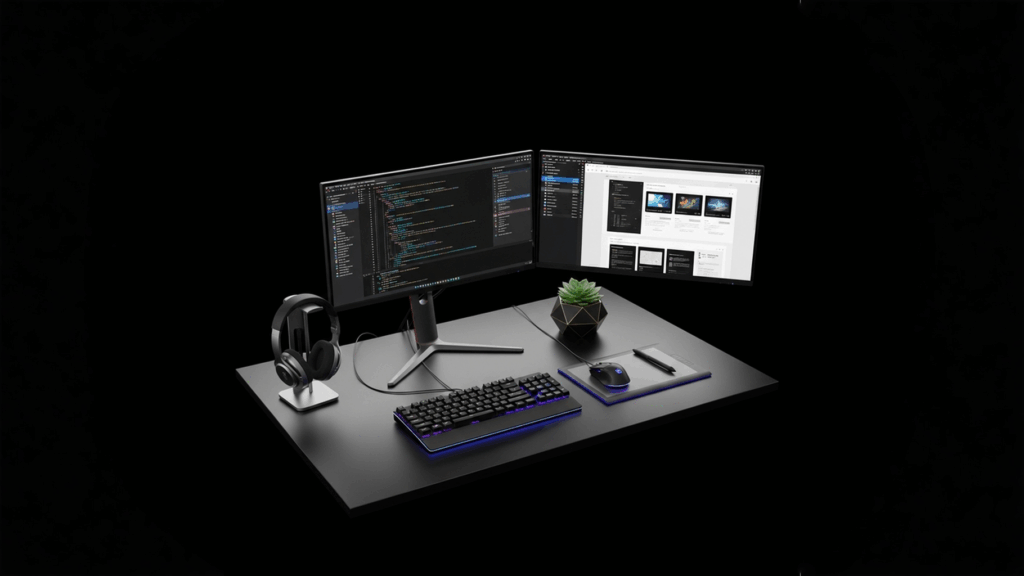Prompt Engineering: Mastering the Art of AI Communication in 2025

I. Introduction: The Dawn of Intelligent Interaction
In an era increasingly defined by artificial intelligence, the ability to communicate effectively with these advanced systems has become paramount. Gone are the days when AI was a niche technology; today, it permeates nearly every facet of our lives, from automating mundane tasks to inspiring groundbreaking creative works. At the heart of this transformative shift lies prompt engineering, a discipline that is rapidly evolving from a technical skill to a fundamental literacy for anyone interacting with AI. Prompt engineering is, at its core, the art and science of crafting precise and effective queries—or “prompts”—that guide generative AI models to produce desired outputs. It’s the crucial process that bridges human intent with AI capability, ensuring that the sophisticated algorithms deliver results that are not just accurate, but also relevant, nuanced, and aligned with specific goals [4]. As we navigate 2025, mastering this nuanced form of communication is no longer just an advantage; it’s a necessity for unlocking the full potential of AI.
II. The Evolution of Prompt Engineering: From Simple Queries to Strategic Commands
The journey of prompt engineering is deeply intertwined with the history of artificial intelligence itself. Its genesis can be traced back to the rudimentary chatbots of the 1960s, such as ELIZA, where even then, the quality of a response was noticeably influenced by the clarity and structure of the input question. This early recognition laid the groundwork for what would become a sophisticated field. As machine learning algorithms advanced, particularly with the development of neural networks, the need for structured inputs became even more apparent; models required precise guidance to interpret tasks correctly and avoid generating irrelevant or nonsensical outputs [4]. The true revolution in prompt engineering, however, began with the advent of transformer architectures, exemplified by models like BERT and the groundbreaking GPT series. These models, capable of processing and generating human-like text after being trained on colossal datasets, transformed the landscape of AI interaction. By the early 2020s, with generative AI systems becoming widely accessible, prompt engineering rapidly ascended from an obscure technical niche to an indispensable skill. Today, it stands as a core competency, essential not only for AI developers and researchers but also for professionals across diverse sectors, including marketing, education, and creative industries [4]. This evolution underscores a fundamental truth: as AI grows more powerful, so too does the importance of human ingenuity in directing its capabilities.
III. The Current Landscape: Prompt Engineering in October 2025
As of October 2025, the landscape of prompt engineering is characterized by explosive growth and an undeniable strategic importance. It has transcended its technical origins to become a pivotal discipline for anyone seeking to harness the power of artificial intelligence effectively. The ability to articulate precise and effective instructions to AI is no longer a mere technical proficiency; it’s a critical strategic advantage in a world increasingly shaped by AI’s influence across all sectors [4].
Market Growth and Economic Impact
The economic footprint of prompt engineering is expanding at an astonishing rate. The global prompt engineering market is currently valued at an estimated $505 billion in 2025, with ambitious projections indicating a surge to US $6.5 trillion by 2034, according to insights from Precedence Research [1]. Other analyses corroborate this rapid expansion, with one report forecasting growth from $2.19 billion in 2024 to $32.78 billion by 2035, demonstrating a robust Compound Annual Growth Rate (CAGR) of 30.19% from 2025 to 2035 [2]. A third perspective suggests an increase from $2.189 billion in 2025 to $7.5 billion by 2030 [3]. These figures underscore not just a burgeoning market, but a foundational shift in how industries are investing in AI interaction.
Widespread Adoption and Skill Demand
The pervasive integration of generative AI tools across industries further highlights the relevance of prompt engineering. By 2025, an impressive over 80% of businesses are anticipated to be leveraging generative AI tools [5]. This widespread adoption signifies a profound transformation in digital strategy, where AI-driven capabilities are becoming standard rather than exceptional. Consequently, the demand for skilled prompt engineers has skyrocketed. LinkedIn job postings specifically referencing “prompt engineering” have witnessed an astounding 434% surge since 2023 [1]. The value placed on this expertise is also reflected in compensation: certified prompt engineers are reportedly commanding salaries that are 27% higher than their uncertified counterparts, and a significant 68% of firms are now actively providing training in prompt engineering to upskill their workforce [1].
The Cost of Poor Prompting
Despite the clear benefits, the criticality of effective prompting is starkly illuminated by the challenges many organizations face. A pivotal 2025 study revealed that a staggering 78% of AI project failures can be attributed to poor human-AI communication [1]. This statistic serves as a powerful reminder that even the most advanced AI models are only as effective as the instructions they receive. Conversely, teams that prioritize and excel in prompt engineering report approximately 340% higher Return on Investment (ROI) compared to those relying on ad-hoc or poorly constructed prompts [1]. This demonstrates that investing in prompt engineering is not just about optimizing AI output, but directly impacting business success and innovation.

IV. The Core Principles of Effective Prompting
Regardless of the AI model or the task at hand, certain universal principles underpin the creation of effective prompts. These principles act as a compass, guiding users toward clearer, more precise, and ultimately more successful AI interactions.
Clarity and Specificity: The Bedrock of Good Prompts
The most fundamental rule of prompt engineering is to be clear and specific. Ambiguity is the enemy of effective AI communication. Just as a chef needs a precise recipe to create a culinary masterpiece, an AI model requires unambiguous instructions to generate the desired output. Vague requests like “Write about marketing” will inevitably lead to generic, uninspired results. In contrast, a prompt such as “Draft a compelling social media post for a new eco-friendly skincare line, highlighting its vegan ingredients and cruelty-free certification, targeting environmentally conscious millennials with an enthusiastic and informative tone” leaves no room for misinterpretation, guiding the AI to a highly relevant and impactful outcome [4]. The more precisely you articulate your needs, the higher the likelihood of obtaining a perfectly tailored response.
Context is King: Providing Background and Scope
AI models, while powerful, lack inherent understanding of the broader situation surrounding your request. Providing adequate context is therefore paramount. This involves giving the AI the necessary background information, defining its role, and setting the boundaries for its response. For instance, instructing an AI to “Summarize this research paper” is a good start, but adding “Summarize this research paper on quantum computing, focusing on its implications for cybersecurity, for an audience of non-technical business executives” transforms a simple summary into a targeted, valuable piece of content. Context helps the model understand the why behind your request, enabling it to filter information and adopt the appropriate style, tone, and level of detail [4].
The Power of Examples (Few-Shot Prompting): Guiding AI with Demonstrations
One of the most effective ways to teach an AI what you expect is by showing it. This technique, often referred to as few-shot prompting, involves providing the AI with one or more examples of input-output pairs that demonstrate the desired behavior. If you want the AI to generate text in a very specific, idiosyncratic style, simply describing that style might not be enough. However, providing a few sentences written in that style as an example will give the AI a concrete reference point, significantly improving its ability to mimic the desired aesthetic [4]. This is particularly powerful for tasks requiring creative flair, specific formatting, or adherence to complex stylistic guidelines.
Iterative Refinement: The Continuous Loop of Prompt Optimization
Prompt engineering is rarely a one-shot process. It is, by its very nature, an iterative journey of refinement. The first prompt you write might not yield perfect results, and that’s entirely expected. The key is to view this as an opportunity for improvement. Analyze the AI’s initial response: What worked? What didn’t? What was missing? Then, refine your prompt by adding more details, adjusting the wording, clarifying ambiguities, or incorporating new examples. This continuous loop of experimentation, analysis, and refinement is crucial for honing your prompting skills and achieving increasingly precise and satisfactory outcomes [4]. Don’t be afraid to experiment; each iteration brings you closer to mastering the AI’s capabilities.
Modularity: Breaking Down Complex Tasks
For highly complex tasks, attempting to cram all instructions into a single, monolithic prompt can overwhelm the AI and lead to suboptimal results. A more effective strategy is to employ modularity, breaking down the larger task into smaller, more manageable sub-tasks, each addressed by a separate, focused prompt. For example, instead of asking an AI to “Write a comprehensive marketing plan for a new tech startup, including market analysis, competitive landscape, target audience, branding strategy, and a 6-month content calendar,” it’s far more effective to break it down: first, prompt for market analysis, then competitive landscape, and so on. This modular approach allows for greater control over each stage of the AI’s output, ensuring that complex projects are handled systematically and results are structured and coherent [4].

V. Prompt Engineering for Video Generation: Bringing Ideas to Life
While text-based AI has dominated the conversation, the frontier of generative AI is rapidly expanding into visual mediums, with AI video generation emerging as a particularly transformative capability. Imagine transforming a simple textual description into a dynamic, visually rich video clip in moments. This is no longer science fiction; it’s a rapidly evolving reality, and prompt engineering is the key to unlocking its creative potential. Crafting effective prompts for video AI requires a nuanced understanding of both cinematic language and the specific capabilities of these advanced models.
Key Elements of Video Prompts
Generating compelling video content with AI demands highly descriptive and clear prompts. To guide the AI towards your vision, consider these fundamental elements, often highlighted in resources like the Google Cloud Vertex AI prompt guide [6]:
- Subject: This defines the central focus of your video. Is it an object, a person, an animal, or a sprawling landscape? Be explicit. For instance, instead of just “a car,” specify “a vintage red convertible driving through a desert landscape.” [6]
- Context: The background or environment where your subject is placed is crucial. Is it a bustling city street, a serene forest, or the vastness of outer space? Providing this context helps set the scene and mood. For example, “a satellite floating through outer space with the moon and some stars in the background” creates a distinct visual environment [6].
- Action: What is your subject doing? This describes the movement or activity within the video. Examples include “walking, running, or turning their head.” A prompt like “a woman walking along the beach, looking content and relaxed and looking towards the horizon at sunset” defines both the action and the emotional state [6].
- Style: This element allows you to dictate the aesthetic of the video. It can be broad, like “cinematic,” or highly specific, such as “horror film,” “film noir,” “cartoon style render,” or even referencing specific artists or art movements. The style dictates the overall visual language and tone [6].
- Camera Motion (Optional but powerful): To add dynamic flair, specify camera movements. Options include “aerial view,” “eye-level,” “top-down shot,” “low-angle shot,” “tracking drone view,” or “POV shot.” For instance, “A POV shot from a vintage car driving in the rain, Canada at night, cinematic” immediately suggests a specific visual experience [6].
- Composition (Optional): This refers to how the shot is framed. You can request a “wide shot,” “close-up,” or “extreme close-up.” For example, “Extreme close-up of an eye with a city reflected in it” creates a dramatic and intimate visual [6].
- Ambiance (Optional): Ambiance dictates the color, lighting, and overall mood of the scene. Think “blue tones,” “night,” “warm tones,” “muted orange warm tones,” or “natural light.” Color palettes significantly influence emotional impact, such as a “warm, golden palette” for a romantic feel or “cool blue tones” for a sad mood [6].
- Audio (Optional): For models that support audio generation, explicitly describe desired sound effects or dialogue. It’s recommended to use separate sentences for audio descriptions. For example, “The man in the red hat says, ‘Where is the rabbit?’ Then the woman in the green dress next to him replies, ‘There, in the woods.'” [6]
Advanced Techniques for AI Video Generators
Beyond these core elements, several advanced techniques can significantly enhance the quality and relevance of AI-generated videos, as highlighted by Data Science Dojo [7]:
- Define Clear Objectives: Before even typing a prompt, clearly articulate the video’s purpose. Is it for a product launch? A social media campaign? What key features, use cases, or customer reactions do you want to convey? Defining these objectives ensures the AI’s output aligns perfectly with your strategic goals [7].
- Detailed Script Prompts: Don’t just provide a script; offer comprehensive instructions regarding voice, tone, and the intended length of the video. Communicate campaign goals and target audience explicitly to ensure the AI-generated video resonates with your strategy [7].
- Visual Descriptions: For a specific visual style, provide rich, detailed descriptions of desired imagery, color schemes, and overall aesthetic. Art directors, for instance, can use AI tools to explore and visualize concepts effectively by supplying granular visual cues [7].
- Storyboarding Assistance: Leverage AI to transform descriptive text directly into visual storyboards. This technique, exemplified by projects where AI converted classic movie texts into visual narratives, demonstrates the powerful link between language and imagery [7].
- Shot List Generation: AI can efficiently convert a script into a detailed shot list, ensuring the desired flow and pacing are maintained within specified timeframes [7].
- Feedback Implementation (Iterative Visual Refinement): Just as with text, visual prompting benefits immensely from iteration. Tools like Midjourney allow users to refine previously generated images, making it easy to fine-tune the visual style until it perfectly matches the creative vision [7]. This iterative feedback loop is crucial for achieving high-fidelity results.
- Creative Experimentation: Embrace the unique
‘natural aesthetic’ that AI can produce. Filmmakers like Paul Trillo advocate for experimenting with new visual styles generated by AI as they become mainstream. This encourages pushing creative boundaries and discovering novel visual languages unique to AI-driven video generation [7].
Negative Prompts for Video: Guiding by Exclusion
A powerful, yet often underutilized, technique in video generation is the use of negative prompts. These instruct the AI on what not to include in the generated video, helping to steer the output away from undesirable elements. Instead of using prohibitive language like “no walls” or “don’t show walls,” the most effective approach is to describe the unwanted elements directly. For example, a negative prompt like “urban background, man-made structures, dark, stormy, or threatening atmosphere” can prevent the AI from generating a video with those characteristics, even if the primary prompt doesn’t explicitly exclude them [6]. This method provides a subtle yet firm control over the AI’s creative process, refining the output by eliminating distractions or unwanted visual noise.
Aspect Ratios: Framing Your Vision
The choice of aspect ratio is fundamental to the visual presentation of any video, and AI video generators typically offer options to accommodate various platforms and viewing experiences. For instance, Vertex AI Veo supports two primary aspect ratios [6]:
- Widescreen (16:9): This is the most common aspect ratio for televisions, monitors, and mobile phone screens in landscape mode. It’s ideal for capturing expansive backgrounds, scenic landscapes, and cinematic narratives. A prompt might specify, “Create a video with a tracking drone view of a man driving a red convertible car in Palm Springs, 1970s, warm sunlight, long shadows,” naturally fitting a widescreen format [6].
- Portrait (9:16): Essentially a rotated widescreen, this aspect ratio has gained immense popularity with short-form video platforms like YouTube Shorts, TikTok, and Instagram Reels. It is best suited for vertical subjects such as portraits, tall objects like buildings or waterfalls, and content designed for mobile-first consumption. An example could be, “Create a video with a smooth motion of a majestic Hawaiian waterfall within a lush rainforest. Focus on realistic water flow, detailed foliage, and natural lighting to convey tranquility.” [6]
Understanding and specifying the appropriate aspect ratio ensures that the AI-generated video is not only visually appealing but also optimized for its intended distribution channel.

VI. Prompt Engineering Across Diverse Fields (Beyond Text and Video)
While text and video generation represent significant applications, the influence of prompt engineering extends across a multitude of industries, fundamentally reshaping workflows and unlocking new efficiencies.
Software Development: Coding with Precision
For software developers, prompt engineering has become an indispensable tool. Generative AI can produce complex programming code, making AI a powerful co-pilot in the development process. Developers leverage AI for routine tasks such as writing functions, debugging code, and generating comprehensive test cases. The key lies in formulating precise requests that enable the AI to understand the task and propose optimal solutions. For example, instead of a generic request like “Write a function to sort an array,” a developer might specify: “Create a Python function to sort an array of numbers in ascending order using the quicksort algorithm. The function should handle empty arrays and include docstrings.” This level of detail not only enhances the quality of the AI-generated code but also significantly reduces the time spent on manual coding and subsequent revisions. AI can further assist with API integration, offering code snippets and guidance on using specific methods or libraries. Beyond coding, prompt engin
Content Creation & Marketing: Crafting Engaging Narratives
In the dynamic realm of content marketing, generative models are actively utilized for crafting articles, product descriptions, social media posts, and blog content. However, the efficacy of these tools hinges entirely on the quality of the prompts provided. Prompt engineering empowers marketers to achieve both precision and creativity simultaneously. A vague request like “Write an advertisement for a new smartphone” will yield generic results. In contrast, a refined prompt such as “Create text for an advertising campaign for a new smartphone. Emphasize its powerful camera, stylish design, and affordable price. The tone should be inspiring, like in Apple’s campaigns, targeting tech-savvy young adults” provides clear instructions and sets the desired creative direction for the AI. Such detailed prompts enable AI to produce unique and compelling texts that resonate with target audiences and stand out in a crowded digital landscape. Moreover, prompt engineering extends beyond mere text generation; it can facili
Education & Training: Personalized Learning at Scale
Prompt engineering is revolutionizing education and training by enabling highly personalized learning experiences. Educators can utilize AI to create adaptive assignments tailored to individual student needs and proficiency levels. For instance, a teacher can prompt the AI: “Create a mechanics problem for a first-year university student with foundational physics knowledge. The problem should involve calculating the acceleration of an object on an inclined plane, incorporating friction. Difficulty level: medium. Provide a step-by-step solution.” This allows for customized challenges that cater to specific learning objectives. Similarly, for language learning, AI can generate exercises, translations, or dialogues adjusted to the learner’s language proficiency. Prompt engineering ensures clear parameters, from the assignment topic to the style and length of the response [4]. These capabilities are also invaluable in corporate training, where organizations can develop industry-specific courses, generate step-by-
Scientific Research: Accelerating Discovery
Scientists are increasingly integrating AI models into their research workflows, and prompt engineering is key to maximizing their utility. AI can assist in processing vast datasets, formulating hypotheses, and even drafting sections of research papers. A prompt like “Analyze this dataset of genetic sequences from a population of fruit flies, identify significant mutations, and draw conclusions about their potential impact on lifespan, presenting findings in a structured report format” can automate complex analytical tasks. This accelerates the pace of discovery, allowing researchers to focus on higher-level interpretation and experimental design [4].
In essence, every field touched by AI becomes a fertile ground for prompt engineering. By mastering the art of crafting effective prompts, professionals can unlock the full potential of these transformative technologies, making them more convenient, accurate, and profoundly useful across diverse applications [4].
VII. Common Pitfalls and How to Avoid Them
Even with the most advanced AI, poorly constructed prompts can lead to disappointing, irrelevant, or even nonsensical outputs. Recognizing and avoiding common pitfalls is crucial for consistent success in prompt engineering.
Too General Requests
One of the most frequent errors is submitting requests that are overly broad or lacking in specific detail. When a prompt is too general, the AI model lacks sufficient guidance and may “get lost” in the vastness of its training data. For example, simply asking “Tell me about history” will yield a superficial and unhelpful overview, as the AI has no specific direction. To avoid this, always strive for granularity. Instead, specify: “Provide a concise summary of the causes and major events of the French Revolution for a high school history class.” This directs the AI to a particular topic, scope, and audience, ensuring a relevant response [4].
Lack of Context
AI models operate based on the information they are given. Without adequate context, they cannot fully grasp the nuances or underlying intentions of a request. If you desire a text to be written in a particular style, for a specific purpose, or from a certain perspective, but fail to provide this context, the AI’s output may be generic, neutral, or simply not meet your expectations. Always define the AI’s persona (e.g., “Act as a seasoned financial advisor”), the target audience, the desired tone, and any relevant background information. This contextual framing is essential for the AI to tailor its response appropriately [4].
Overloaded Requests
While detail is important, combining too many disparate tasks or complex instructions into a single prompt can overwhelm the AI, leading to confusion and fragmented results. If a prompt attempts to achieve multiple, distinct objectives simultaneously, the model may struggle to prioritize or integrate them coherently. The solution is modularity: break down complex requests into a series of smaller, sequential prompts. For instance, instead of asking for a full business plan in one go, first prompt for market analysis, then for a competitive overview, and then for a marketing strategy. This allows the AI to focus on one task at a time, producing higher quality output for each component [4].
Incorrect Language or Tone
The language and tone specified in a prompt directly influence the AI’s output. If the prompt is given in a language the model is less proficient in, or if it contains highly specialized jargon without sufficient explanation, the quality of the response can suffer. Similarly, if the desired tone (e.g., formal, casual, humorous, academic) is not clearly articulated, the AI may default to a neutral or inappropriate style. Always ensure your prompt uses clear, unambiguous language and explicitly states the desired tone and style to align the AI’s output with your communicative goals [4].
Ignoring Iteration
One of the most significant pitfalls is treating prompt engineering as a one-and-done process. Expecting a perfect result from the very first prompt often leads to frustration. As discussed earlier, iteration is a cornerstone of effective prompt engineering. Failing to analyze initial outputs, refine prompts based on feedback, and experiment with different approaches means missing out on significant opportunities for improvement. Embrace the iterative cycle: prompt, evaluate, refine, repeat [4].
Not Utilizing Negative Prompts (Especially for Visual/Video AI)
For generative AI in visual domains (images and video), neglecting negative prompts can lead to unwanted elements creeping into the output. If you don’t explicitly tell the AI what to avoid, it might include elements that detract from your vision. Actively use negative prompts to filter out undesired characteristics, backgrounds, or objects, ensuring a cleaner and more focused result [6]. By consciously avoiding these common mistakes, users can significantly enhance their ability to communicate effectively with AI, leading to more precise, relevant, and valuable outputs across all applications.

VIII. The Future Horizon of Prompt Engineering
Prompt engineering, far from being a transient trend, is solidifying its position as a foundational discipline for human-AI interaction. As we look towards the latter half of the 2020s and beyond, its evolution is poised to accelerate, driven by advancements in generative models and their deeper integration into the fabric of daily life [4].
Trends and Development Prospects
- Automation and Standardization: A significant trend will be the increasing automation and standardization of prompt workflows. We are already witnessing the emergence of platforms that offer sophisticated, ready-made prompt templates tailored for a wide array of purposes—from drafting marketing copy to conducting complex research. In the future, these tools will become even more specialized, potentially incorporating AI-driven mechanisms that can automatically adapt prompts to a user’s specific needs, learning from past interactions and desired outcomes [4]. This will democratize access to advanced prompting techniques, making them accessible to a broader user base.
- Specialized AI Assistants: The development of highly specialized AI assistants, custom-built for particular professional domains, will further refine prompt engineering. Imagine virtual assistants designed exclusively for doctors, lawyers, or educators. These assistants will come equipped with pre-trained interaction scenarios and domain-specific knowledge, significantly simplifying the process of crafting effective prompts within their respective fields. This vertical integration of AI will allow for more nuanced and contextually aware interactions [4].
- Multimodal Models and Integrated Prompting: The future of AI is increasingly multimodal, moving beyond text to seamlessly integrate images, sounds, and video. This shift will necessitate a new generation of prompt design, where a single, comprehensive query might combine textual instructions with visual references, auditory cues, and even haptic feedback specifications. Crafting such integrated prompts will require a holistic understanding of how different sensory inputs contribute to the desired AI output, pushing the boundaries of creative expression and functional utility [4].
- Ethical Considerations and Safety: As AI’s influence on society continues to expand, the ethical implications and safety considerations of its outputs become paramount. Prompt engineering will play a critical role in developing robust mechanisms to control AI behavior, ensuring that generated content adheres to ethical guidelines and prevents the creation or propagation of harmful, biased, or misleading information. This will involve designing prompts that explicitly incorporate ethical constraints and using negative prompts to filter out undesirable content, reinforcing responsible AI development and deployment [4].
- Training and Certification: The burgeoning demand for skilled prompt engineering specialists will inevitably lead to the proliferation of new educational programs, certifications, and academic curricula. This formalization will help to systematize the knowledge and skills required in this rapidly evolving field, making it more accessible and providing clear career pathways for aspiring professionals. Universities, vocational schools, and online platforms will increasingly offer specialized courses, solidifying prompt engineering as a recognized and highly valued profession in the digital economy [4].
Prompt engineering is more than just a set of technical techniques; it represents a profound philosophical shift in how humanity interacts with intelligent machines. It is the key to unlocking AI’s immense potential, transforming it from a complex, often opaque tool into an intuitive, effective, and collaborative assistant. In the coming years, this discipline will not only gain unprecedented momentum but will also become one of the most crucial skills for navigating and shaping our increasingly AI-driven world [4].
IX. Conclusion: Your Gateway to AI Mastery
In conclusion, prompt engineering is no longer a niche skill but a fundamental competency for anyone engaging with artificial intelligence. From its humble beginnings with early chatbots to its current status as a multi-billion dollar industry, its evolution mirrors the rapid advancements in AI itself. As of October 2025, the evidence is clear: mastering the art of crafting effective prompts is directly linked to higher ROI, reduced project failures, and the ability to harness AI’s transformative power across diverse fields, including the burgeoning domain of video generation. By embracing principles of clarity, context, iteration, and modularity, and by strategically utilizing advanced techniques like negative prompts and aspect ratio considerations, individuals and organizations can move beyond basic AI interaction to achieve true AI mastery. The future of prompt engineering promises even greater automation, specialization, and multimodal capabilities, making continuous learning in this field not just beneficial, but essential. As AI continues to reshape our world, the ability to communicate with it effectively will be the ultimate differentiator, empowering us to innovate, create, and solve problems on an unprecedented scale.
X. References
[1] Under the Radar | Weekly Top 5: AI Agents In, Prompt … (n.d.). Retrieved October 17, 2025, from https://medium.com/@angelaf_56127/under-the-radar-weekly-top-5-ai-agents-in-prompt-engineering-out-october-10-2025-775be6218b92
[2] Prompt Engineering Market Size, Share, Trends,Analysis 2035. (n.d.). Retrieved October 17, 2025, from https://www.marketresearchfuture.com/reports/prompt-engineering-market-33533
[3] The Rise of Prompt Engineering: A Booming Field. (n.d.). Retrieved October 17, 2025, from https://www.linkedin.com/pulse/rise-prompt-engineering-booming-field-pandey-pmp-entj-a–dqrsc
[4] What is Prompt Engineering and Why It Is Important for Interacting with AI – BARS Agency Blog. (n.d.). Retrieved October 17, 2025, from https://barsagency.com/blog/chto-takoe-prompt-inzhiniring-i-pochemu-on-vazhen-dlya-vzaimodejstviya-s-ai
[5] AI Prompts Guide: Unlocking Creative Power in 2025. (n.d.). Retrieved October 17, 2025, from https://accountabilitynow.net/ai-prompts/
[6] Veo on Vertex AI video generation prompt guide | Generative AI on Vertex AI | Google Cloud. (n.d.). Retrieved October 17, 2025, from https://cloud.google.com/vertex-ai/generative-ai/docs/video/video-gen-prompt-guide
[7] AI Video Generators: 7 Useful Prompting Techniques to Use. (n.d.). Retrieved October 17, 2025, from https://datasciencedojo.com/blog/prompting-to-use-ai-video-generators/



